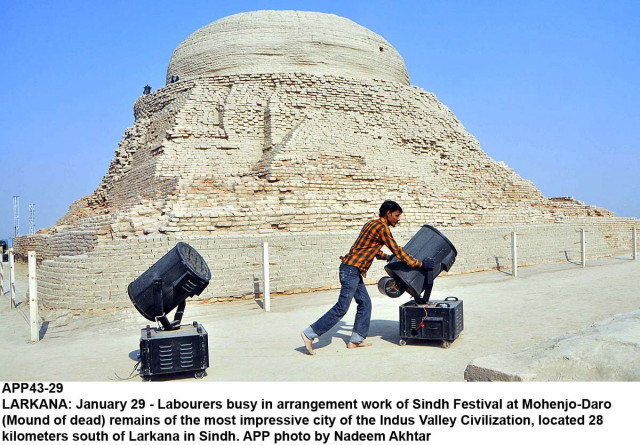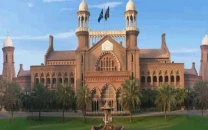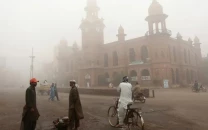Mohen jo Daro: Preserving the ruins by ruining them
No precautions had been taken in the handling of one of the most cherished preserved historical sites in the world.

Workers move heavy lights near the stupa of Moenjo Daro, a world heritage site, with metal pylons for the upcoming Sindh Festival visible in the background. PHOTO: APP
“The pyramids of Egypt were built by thousands of people to serve one man while Mohen jo Daro was built by thousands of people to serve thousands more.” Bilawal Bhutto Zardari’s statement at the opening ceremony of the Sindh Festival, widely seen as his attempt to dip a toe in Pakistan’s political waters, sums up the nature of the Indus Valley civilisation’s dwellers.
Pacifist in nature, these residents of the valley are believed, according to one historical account, to have perished not because of economic crises or natural catastrophes but because they did not possess the necessary weapons to defend themselves against the charge of an invading army.
Some 5,000 years later, what is left of these dwellers was besieged once more – the ruins of Mohen jo Daro were exploited and manhandled at the launching ceremony of the Sindh Festival on the 1st of February.
Picture Mohen jo Daro a night before this event: workers and electricians swarm the landscape and under the din of hammers, carpenters assemble parts of a stage for the ceremony. One worker is attempting to remove a long, thick nail supporting the tent that hems the audience at the venue – it has been hammered into one of the ruins. “They say our forefathers are buried here, so take out that nail,” he tells The Express Tribune. “I don’t know why they didn’t know that their forefathers are buried here while I was hammering in that nail,” he complains. “Anyway, who cares? I am just following orders here.”
From the audience’s vantage point, the brightly lit stupa – the backdrop to the festivities onstage – looks beautiful. The ruins are dotted with the figures of young men and women walking or perfecting their dance moves on sites that they were not permitted to set foot on.
“We are Aryans,” pronounced one of the dancers, perched on a low wall of one of the colonies. “And we’ll attack the Indus Valley civilization through the performing arts.”
The stupa, a familiar sight from the image printed on Pakistani ten rupee notes, has come to life tonight – surrounded by powerful beams of lights on the ground and supporting six to seven spotlights. The only way these lights could have been placed atop the stupa was in the hands of labourers climbing the monument – unless, of course, robots or helicopters were deployed to carry out the task. The lights throw the stupa, a Buddhist monastery built in 2 AD, almost sixteen centuries after the Indus Valley civilisation ended, into multi-coloured relief.
The stage is encircled by a hefty grid of lights. A cameraman paces, confused with directives received about framing his shot while steering clear of the heritage sites. “We took precautions two days ago, when the Sindh High Court issued a notice,” he says. “Before that, no one had the faintest clue that such an issue would arise.” This space, he explains, is just another venue for the workers. “You should have seen how the sweepers and labourers entered the site on the first day – jaisay unn ke baap ki jagaa hai (as if this place belongs to their father),” he says. “They treated it just like another venue and you couldn’t really do anything about it because you can barely communicate with them.” The Mohen jo Daro guesthouse is located on the premises; but there are no public toilets onsite. Performing artists practising backstage, encumbered by the distance of the guesthouse and the countless security checks to and from the site, must have asked the question all the labourers and police force (instructed not to leave their posts) must have wondered – where does one answer the call of nature in such a situation? “For the labourers, this was an open ground – they didn’t think twice about spitting paan or doing anything else if needed,” the cameraman says.
Walk behind the stupa and you spotted boxes and barrels of fireworks dotting the ruins, staff sitting next to the crates to safeguard them. Fire extinguishers and emergency materials were missing, an absence noted when a small fire broke out backstage as performers attempted to light a torch that was part of the ‘Aryan invasion’ tableau. A band manager swatted at the flames with his bare hands, eventually putting out the fire. With no designated space to store their equipment the artists had no choice but to use the remains as a surface.
While the extent of the damage to the site from these activities could not be gauged, one thing was clear – no precautions had been taken in the handling of one of the most cherished preserved historical sites in the world. According to the festival’s coordinator, Fakhr-e-Alam, a total of four to five hundred workers were present onsite the night of the opening ceremony alone. An archaeologist may be dispatched to take note of any damage to the site, but unless this archaeologist visited Mohen jo Daro four days prior to the festival’s opening ceremony, it may be difficult to set the scene, wherein hundreds cordoned off the ancient city in order to prepare it for the night’s festivities.
The Express Tribune contacted Fakhr-e-Alam regarding this but he had not responded with his comments at the time of publishing.
Published in The Express Tribune, February 19th, 2014.


















COMMENTS
Comments are moderated and generally will be posted if they are on-topic and not abusive.
For more information, please see our Comments FAQ